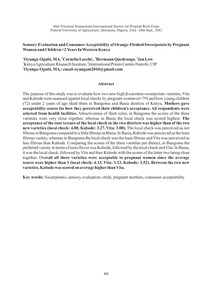Sensory evaluation and consumer acceptability of orange-fleshed sweetpotato by pregnant women and children < 2 years in western Kenya.
Abstract
The purpose of this study was to evaluate how two new high â-carotene sweetpotato varieties, Vita and Kabode were assessed against local checks by pregnant women (n=79) and how young children (72) under 2 years of age liked them in Bungoma and Busia districts of Kenya. Mothers gave acceptability scores for how they perceived their children's acceptance. All respondents were selected from health facilities. Attractiveness of flesh color, in Bungoma the scores of the three varieties were very close together, whereas in Busia the local check was scored highest. The acceptance of the root texture of the local check in the two districts was higher than of the two new varieties (local check: 4.00, Kabode: 3.27, Vita: 3.00). The local check was perceived as not fibrous in Bungoma compared to a little fibrous in Busia. In Busia, Kabode was perceived as the least fibrous variety, whereas in Bungoma the local check was the least fibrous and Vita was perceived as less fibrous than Kabode. Comparing the scores of the three varieties per district, in Bungoma the preferred variety in terms of taste/flavor was Kabode, followed by the local check and Vita. In Busia, it was the local check, followed by Vita and then Kabode with the scores of the latter two being close together. Overall all three varieties were acceptable to pregnant women since the average scores were higher than 3 (local check: 4.13, Vita: 3.23, Kabode: 3.52). Between the two new varieties, Kabode was scored on average higher than Vita.

